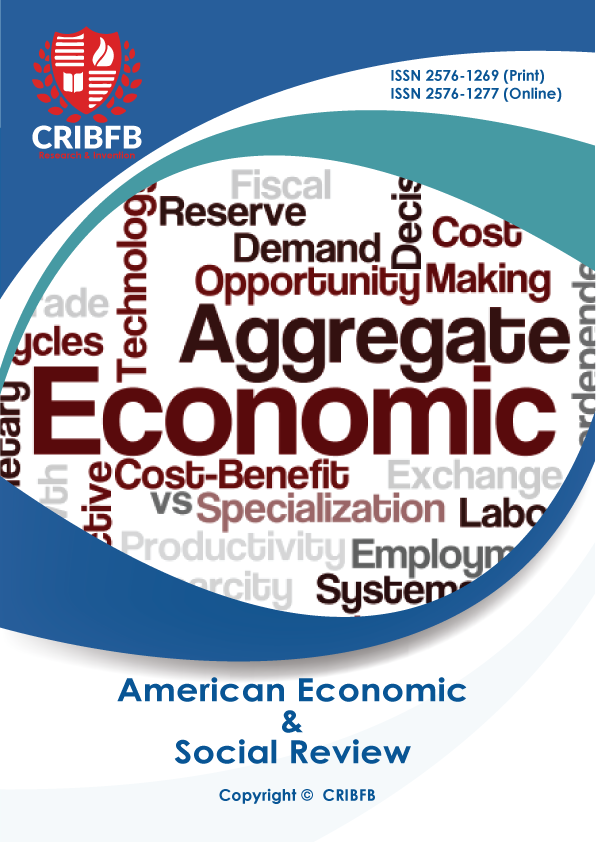SOCIAL CAPITAL, EDUCATION AND CHOICE JOB SEARCH METHODS IN SENEGAL
Main Article Content
Abstract
The objective of this paper is to analyze the microeconomic impact of education on well-being, as measured by social capital in terms of the different means used to search for a job in Senegal. The endogenous variable (social capital) is categorized into four sub-modalities represented as follows: « Personal relations », « Advertisements-firms » composed of advertisements/media/internet and applications to firms; « Agencies-State » composed of the civil service, the employment office, private placement agencies and competitions/tests; and « Other » composed of the search for partners, the search for financing or any other means. The exogenous characteristic variables are the different levels of education (primary, middle, secondary and higher), the gender, the age and the marital status of the individuals aged at least 15 years. The data come from the ANSD's (2020) Senegal Poverty Monitoring Survey database on a sample of 168,203 individuals. Using Stata, the results obtained through estimation by the multinomial logistic method (MLM) show that only higher education has a positive and significant impact on all the means used to look for a job in Senegal, but at different levels and probabilities. This article suggests a strong expansion of networks of acquaintances and mutual aid because the higher the individual's social capital, the more chance he has of interacting with others, broadening his contacts and improving his well-being. Combined with a higher level of education, it offers job-seekers more opportunities to succeed in their search.
JEL Classification Codes: A13, I31, I21, D90, C51.
Downloads
Article Details
Section
How to Cite
References
ANSD. (2020). The economic and social situation of Senegal 2018: Employment. Retrieved from https://www.ansd.sn/ressources/ses/chapitres/4-SES-2017-2018_Emploi.pdf
Bourdieu, P. (1997). Cultural reproduction and social reproduction. Retrieved from https://edu301s2011.files.wordpress.com/2011/02/cultural-reproduction-and-social-reproduction.pdf
Bynner, J., & Ashford, S. (1994). Politics and participation: Some antecedents of young people's attitudes to the political system and political activity. European Journal of Social Psychology, 24(2), 223–236. https://doi.org/10.1002/ejsp.2420240202
Burt, R. S. (1995). Structural holes: The social structure of competition. French Journal of Sociology, 36(4), 779-781. http://dx.doi.org/10.2307/3322456
Boutin. (2010). Egality and Gender. Retrieved from https://luxdev.lu/files/documents/Genre_SEN_vF
Cisse, M. (2005). Determinants of unemployment in Senegal. Retrieved from https://hdl.handle.net/10855/43613
Dupray, A., & Vignale, M. (2019). Graduates returning to their departement of origin: what territory says about the influence of social capital. Youth & Society Review, 4(2), 63-93. https://doi.org/10.7202/1070495ar
Emler, N., & Fraser, N. (1999). Politics: the education effect. Oxford Review of Education, 25(1-2), 251-273. https://doi.org/10.1080/030549899104242
Ensel, W. M., & Vaughn, J. C. (1981). Social resources and strength of ties: Structural factors in occupational status attainment. American Sociological Review, 46(4), 393-405. https://doi.org/10.2307/2095260
Forse, M. (2001). The specific role and growth of social capital. OFCE Review, 1, 189-216. https://doi.org/10.3917/reof.076.0189
Gakou, A. D., & Kuepie, M. (2008). Level and determinants of women's integration into the labor market in Mali. Retrieved from https://dial.ird.fr/wp-content/uploads/2021/12/2008-09.pdf
Granovetter, M. S. (1973). The strength of weak ties. American Journal of Sociology, 78(6), 1360-1380. https://doi.org/10.1086/225469
Granovetter, M. S. (1982). The strength of weak ties. In P. Marsden & N. Lin (Eds.), Social structure and network analysis (pp. 105-130). Beverly Hills/London/New Delhi: SAGE
Hinton, D. (2011). Wales is my home: Higher education aspirations and student mobilities in Wales. Children's Geographies, 9(1), 23-34. https://doi.org/10.1080/14733285.2011.540436
Kamanzi, C., & Deblois, L. (2007). Influence of social capital on human capital formation in resilient students from disadvantaged socioeconomic backgrounds. Review of Education Sciences, 33(1), 127-145. https://doi.org/10.7202/016192ar
Kamanzi, P. C., & Trottier, C. (2010). Access to permanent employment after postsecondary graduation in Canada: does social capital matter? McGill Journal of Education, 45(1), 93-113. https://doi.org/10.7202/1000032ar
Lin, N. (1995). Social Resources: a theory of social capital. Sociology French of Review, 36(4), 685-704. https://doi.org/10.2307/3322451
Lin, N. (2000). Inequality of social capital. American Sociological Review, 29(6), 785-795. https://doi.org/10.2307/2654086
Njikam, G. B. N., & Mwaffo, V. F. (2005). Characteristics and determinants of youth employment in Cameroon. Retrieved from http://www.ilo.org/public/libdoc/ilo/2005/105B09_120_fren.pdf
Nouzha, N., & Outtaj, B. (2020). The return to education in the Moroccan labor market: a microeconometric analysis. Review Benchmark And Perspective Economic, 4(2), 266-282. https://doi.org/10.34874/IMIST.PRSM/RPE/21543
Putnam, R.D. (1995) Bowling Alone: America’s Declining Social Capital. Journal of Democracy, 6(1), 65-78. https://doi.org/10.1353/jod.1995.0002
Rosvall, P. A., Rönnlund, M., & Johansson, M. (2018). Young people's career choices in Swedish rural contexts: Schools' social codes, migration and resources. Journal of Rural Studies, 60, 43-51. http://dx.doi.org/10.1016/j.jrurstud.2018.02.007
Sibony, D. (2016). Social capital: the dimensions of a relevant concept. Retrieved from http://journals.openedition.org/sas/1728
Sorin, V. (2010). Social capital extension in adult education. Retrieved from https://ciea.usm.md/resources/2010/23%20sorin%20vlad%20predescu.pdf
Van Deth, J., & Maraffi, M. (1999). Social Capital and European Democracy. Retrieved from https://books.google.sn/books?id=ZR2EAgAAQBAJ
Wagner, A. C. (2007). Social class and globalization. Sociology Benchmark, 40, 89-98. https://doi.org/10.3917/dec.wagne.2007.01




